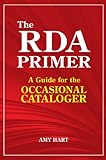The RDA primer : a guide for the occasional cataloger / Amy Hart.
Tipo de material: TextoEditor: Santa Barbara, Cal. : Linworth, c2010Descripción: xiii, 89 páginas : ilustraciones ; 24 cmTipo de contenido:
TextoEditor: Santa Barbara, Cal. : Linworth, c2010Descripción: xiii, 89 páginas : ilustraciones ; 24 cmTipo de contenido: - texto
- no mediado
- volumen
- 9781586833480
- 9781598847475 (ebook)
- Z694.15.R47 H37 2010
| Tipo de ítem | Biblioteca actual | Signatura | Copia número | Estado | Fecha de vencimiento | Código de barras |
|---|---|---|---|---|---|---|
|
|
BURRF: FG (PP) | Z694.15.R47 H37 2010 | 1 | 1080236252 | ||
|
|
BURRF: FG (PP) | Z694.15.R47 H37 2010 | 2 | 1080236253 |
Incluye referencias bibliográficas (páginas 83-86) e índice.
History and development of RDA -- What is FRBR? Who is FRAD? -- FRBR and FRAD entities -- FRBR and FRAD relationships -- AACR2 to RDA -- Changes from AACR2 to RDA -- MARC changes -- Putting it all together -- RDA and library systems -- The metadata community -- RDA and metadata -- RDA and you.
This book traces the development of RDA, explaining why it was needed and how it was developed. The basics of the conceptual models for RDA are covered, showcasing the origins of the structure and vocabulary of RDA. It then compares AACR2 to RDA and looks at specific changes in the cataloging code. The author also addresses how this development may enable library data to be housed on the Semantic Web and provides practical advice that librarians and catalogers can act upon now to prepare for RDA.


